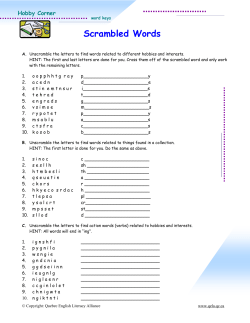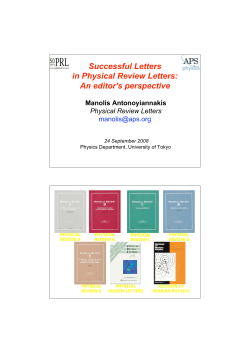
WRITING PHYSICS PAPERS 101 Publish or Perish
WRITING PHYSICS
PAPERS
101
Publish or Perish
J. F. Presentation of Scientific Results
reading about physics writing
M. Alley, The craft of scientific writing, 3rd Ed.,
Springer New York, 1996.
B. Goss Levi: Some simple rules of writing
http://www.research.att.com/kbl/APS/dec97/rules.html
D. Mermin: What’s wrong with this prose?
Physics Today, May 1989, p.9
D. Mermin, What‘s wrong with these equations?
Physics Today, October 1989, p.9
D. Mermin: Writing physics
http://www.lassp.cornell.edu/~cew2/KnightLecture.html
J. F. Presentation of Scientific Results
OUTLINE
Why are we writing papers?
What physics journals there are?
Structure of a physics article
LaTeX 001
Hints for effective writing
Submit & fight
J. F. Presentation of Scientific Results
WHY ARE WE WRITING
PAPERS?
J. F. Presentation of Scientific Results
To communicate our original, interesting, and useful
research
To let others know what we are working on (and that we
are working at all)
To organize our thoughts
To formulate our research in a comprehensible way
To secure further funding
To further our careers
To make our publication lists look more impressive
To have fun?
Because we believe someone is going to read it!!!
J. F. Presentation of Scientific Results
WHAT PHYSICS JOURNALS
ARE THERE?
J. F. Presentation of Scientific Results
Hard-science journals
Physical Reviews series
9 Physical Review A
9 Physical Review E
pra.aps.org
pre.aps.org
atomic, molecular, and optical physics
9 Physical Review B
statistical, nonlinear, and soft matter physics
9 Physical Review Letters (PRL)
prb.aps.org
prl.aps.org
condensed matter and materials physics
9 Physical Review C
prc.aps.org
breakthroughs in all areas
9 Reviews of Modern Physics
rmp.aps.org
nuclear physics
9 Physical Review D
reviews in all areas
prd.aps.org
particles, fields, gravitation and cosmology
J. F. Presentation of Scientific Results
Applied Physics Series
9 Journal of Applied Physics
jap.aip.org
9 Applied Physics Letters
apl.aip.org
J. F. Presentation of Scientific Results
European Physics Journal Series
9 EPJ A
www.edpsciences.org/epja
hadrons and nuclei
9 EPJ E
www.edpsciences.org/epje
soft matter
9 EPJ B
www.edpsciences.org/epjab
9 Europhysics Letters
www.edpsciences.org/epl
condensed matter
9 EPJ C
www.edpsciences.org/epjc
all areas: breakthroughs
particles and fields
9 EPJ D
www.edpsciences.org/epjd
atoms, molecules, and clusters
J. F. Presentation of Scientific Results
Nature and Science
Nature
http://www.nature.com
Science
http://www.sciencemag.org
J. F. Presentation of Scientific Results
Soft-science journals
9 Physics Today
www.physicstoday.org
official journal of APS, good review articles and reseach news
9 Physics World
physicsweb.org
Institute of Physics, good review articles
9 Scientific American
www.sciam.com
popular science articles
9 American Journal of Physics
ojps.aip.org/ajp
pedagogical physics research articles
J. F. Presentation of Scientific Results
Impact Factors
how much is your article worth?
Institute for Scientific Information (ISI)
isi6.isiknowledge.com
Roughly average citation per article
J. F. Presentation of Scientific Results
ISI 2002 impact factors of selected
physics journals
Nature
Science
Rev. Mod. Phys.
Adv. Phys.
Phys. Rep.
Phys. Rev. Lett.
Nucl. Phys. B
Phys. Today
Phys. Rev. D
Appl. Phys. Lett.
Phys. Rev. B
Phys. Rev. A
Phys. Rev. C
Phys. Rev. E
J. Appl. Phys.
EPJ E
EPJ B
J. F. Presentation of Scientific Results
30.432
28.956
23.672
13.952
12.645
7.523
5.409
5.000
4.358
4.207
3.327
2.986
2.848
2.397
2.281
2.188
1.741
Citations
how much is your article really worth?
isi6.isiknowledge.com
SPIRES HEP reference search:
www-library.desy.de/spires/hep/
J. F. Presentation of Scientific Results
Preprint Archives
free, fast, referee free
www.arxiv.org
xxx.lanl.org
J. F. Presentation of Scientific Results
STRUCTURE OF A PHYSICS
ARTICLE
J. F. Presentation of Scientific Results
Short letters
PRL, APL, rapid communications, …
1-4 pages
Title
Abstract
Homogeneous body includes introduction
and acknowledgments
0-4 figures
At most paragraph titles
J. F. Presentation of Scientific Results
Regular articles
4-500 pages
Title
Abstract
Introduction
Body sections
Conclusions/Summary
Acknowledgments
References
Appendices
J. F. Presentation of Scientific Results
Title
informative, catchy, concise
Semicolons?
Why not, if it helps, though some consider
them bad taste.
J. F. Presentation of Scientific Results
Abstract
concise, direct, informative
Passive or active voice?
I prefer passive, though in longer abstracts
an occasional active assertion may be
enlivening.
Abstracts are now more important than ever due to the increasing large number of
articles. One cannot read all the papers in each issue of PRL, not even in ones
own field. Abstracts should state major findings, even some specifics (numbers,
formulas showing basic trends).
J. F. Presentation of Scientific Results
examples
J. F. Presentation of Scientific Results
Introduction
Give the first impression about the paper
Place the work into broader context
Relate to other relevant research
Say why is the work important, in plain language
State major achievements/limitations
State techniques/methods
Describe organization of the paper
J. F. Presentation of Scientific Results
J. F. Presentation of Scientific Results
Body of the paper
Describe your findings in an organized,
structured, and logical way
•Think about the organization ahead of actual writing
•Create informative headings helping easy orientation
J. F. Presentation of Scientific Results
Conclusions
Give your article closure
Summary of major results
Prospects for future extensions
Possible applications, relevance to other
works, fields
J. F. Presentation of Scientific Results
Conclusions example
J. F. Presentation of Scientific Results
LaTeX 101
text, equations, figures, tables, references
J. F. Presentation of Scientific Results
LaTex
http://www.latex-project.org/
REVTeX 4
To compile Phys. Rev. Style documents
http://publish.aps.org/revtex4/
TeX archive network
http://www.ctan.org/ctan/
J. F. Presentation of Scientific Results
Compiling LaTex
latex paper.tex
bibtex paper.tex
latex paper.tex
latex paper.tex
dvips paper.dvi
gv paper.ps
% compile the file
% compile references
(if.bib) exists
% compile again
% compile yet again
% create a .ps file
% view the .ps file
J. F. Presentation of Scientific Results
template for PRL
\documentclass[aps,prl,floatfix,twocolumn,footinbib]{revtex4}
\usepackage{epsfig}
\begin{document}
\title{Template}
\author{Jaroslav Fabian}
\affiliation{Institute for Theoretical Physics, Karl-Franzens
University, Universit\"atsplatz 5, 8010 Graz, Austria}
\author{Albert Newton}
\affiliation{Center for extraterrestrial research, Washington DC}
\begin{abstract}
A LateX template is provided to generate physics papers fast and
easy.
\end{abstract}\maketitle
J. F. Presentation of Scientific Results
inserting figures
\begin{figure}
\centerline{\psfig{file=fig.eps, width=1\linewidth}}
\caption{Template figure. Put your caption here}
\label{fig:1}
\end{figure}
J. F. Presentation of Scientific Results
writing equations
To place equations in line write $s_x=a+b$. Symbol \$ separates the
math format.
This is how single equations are written between lines:
\begin{equation}
\delta s=\int_0^1
\gamma_{2,be}\cosh(w_b/L_{nb})s_{0b}\exp(qV_{be}/k_BT)dq.
\end{equation}
This is how multiple equations are written:
\begin{eqnarray} \label{eq:2}
a&=&\sum_{i=1}^{\infty}, \\
b&=&\log(x).
\end{eqnarray}
J. F. Presentation of Scientific Results
sections
\section{\label{sec:Intro} Introduction}
In this section …
\section{\label{sec:model} Model}
We discuss the model introduced in Sec. \ref{sec:Intro}. The details
are shown
In Fig. \ref{fig:1}. Our work is published in Ref.
\cite{Newton2000:PRL}.
J. F. Presentation of Scientific Results
references
\bibliographystyle{apsrev}
\bibliography{references}
Separate file reference.bib contains references in
the following format:
@Article{Newton2000:PRL,
author = “I. Newton",
title = “On falling apples",
journal= “Phys. Rev. Lett.",
volume = “00",
year = “2000",
pages = “1-5"
}
J. F. Presentation of Scientific Results
finish
\end{document}
J. F. Presentation of Scientific Results
HINTS FOR EFFECTIVE
WRITING
something about style
J. F. Presentation of Scientific Results
disclaimer
I am not a native English speaker and I am not a creative-writing
professional. Everything that follows should be taken as my best
attempt to teach my students intricacies and idiosyncrasies of
physics writing, based on my own experiences and on reading inspiring
literature. I claim no responsibility to the damage inflicted on
students by following my advice too closely and producing
unintelligible and grammar offensive research articles. Beware of my
grammar hints. I am especially offensive to the articles (“the”, “a”, “an”, and
the worst of all, none, “…”). I feel absolved by being a Slavic language (read:
article-free) native speaker.
J. F. Presentation of Scientific Results
Hint 1
Pick a published paper you like and try to
emulate its structure and style
Learn from eminent physics writers
Some of my favorite physics writings are:
•S. Weinberg: Relativity and Cosmology
•Feynman, Leighton, Sands: Feynman Lectures in Physics
•Landau and Lifschitz: Course in Theoretical Physics (*)
(*)I
would not recommend emulating the style of L&L in research papers, unless you
can emulate their physics.
J. F. Presentation of Scientific Results
Hint 2
Understand what you write, be clear
Distance yourself from the writing to see
it unbiased
Logic must flow
Ask a colleague if in doubt that writing
may be incomprehensible
useful point: Do not write “The energy increases with pressure”, but
“The energy increases with increasing pressure”, to be clear, since one can
often mean the opposite (“At low fields the rate decreases” can mean that
the rate increases with decreasing fields, but one never knows.)
J. F. Presentation of Scientific Results
Hint 3
structuring into ideas
=
structuring into paragraphs
Place clue sentences in the beginning
Read the paragraph and rewrite it if the
logic does not flow
J. F. Presentation of Scientific Results
Hint 4
Write in active voice
I show that the process occurs
These results show that ...
(NO: It is shown by these results that ...)
Be concise, precise, and direct
Stay focused
J. F. Presentation of Scientific Results
Hint 5
Be consistent
If there is an allowed ambiguity, stick to
your choice throughout the paper:
For example: “We take five configurations
for the macrostate. Each microstate is defined by …”
Either pick microstate or configuration, some may get
confused. Similarly with grammar. For example, if you
describe an experiment in the past sense, do not switch
randomly to the present one.
J. F. Presentation of Scientific Results
Hint 6
No offense
Avoid if possible words like
Clearly
Obviously
As is well known
Of course
J. F. Presentation of Scientific Results
Hint 7
Read the guidelines
Early in your professional life read the
guidelines for authors to the journal you
write for. Adhere to the most relevant
points in future writings.
J. F. Presentation of Scientific Results
Hint 8
Do not overdo
Footnotes
In-line equations
References
Figures
Latin phrases
Acronyms
J. F. Presentation of Scientific Results
Hint 9
referring
Include only equations, figures, tables, and
references that you refer to
Carefully define every term in equations
Define all the lines and symbols in figures
Each figure and table comes with a caption
Number all equations
All nontrivial statements should be explained or
referenced
J. F. Presentation of Scientific Results
Hint 10
Revise 5-10 times
Spell check
Grammar check
Check for flow
Shorten
Give the paper to a colleague for opinion
Stop revising after a revision eliminates a
previous revision, or if you are revising 10th
time. There is little chance you will improve
anything.
J. F. Presentation of Scientific Results
Final hint
Do not put too much emphasis on writing.
It is a tool to communicate your
research, no less and no more.
An average paper is cited perhaps 4 times, and read
perhaps 7 (4 plus 2 referees plus 1 random reader)
times. You need to balance your time. I know of terribly
written articles that are cited 500 and more times. In
the end, it is the idea that you present, and not the
form of the presentation, that will be remembered.
J. F. Presentation of Scientific Results
Single authors:
I or we?
I prefer I when addressing work done by
myself:
I show that …
Using we is more formal and
authoritative; it diffuses responsibility
There can still be we, if inviting the
reader to join the discussion:
If we substitute A for B
or
If one substitutes A for B
J. F. Presentation of Scientific Results
Hints for effective writing
à la Barbara Goss Levi (*)
(*) http://www.research.att.com/kbl/APS/dec97/rules.html
J. F. Presentation of Scientific Results
1. Practice writing short summaries of
longer articles
(get the message out)
2. Combine writing with inspiring reading
(emulate the style of your favorite writing)
3. Get rid of superfluous words
(there is …, the fact that ...)
J. F. Presentation of Scientific Results
4.
5.
6.
Rewrite if it is not clear
Define your terms
Good writing is clear thinking
J. F. Presentation of Scientific Results
SUBMIT & FIGHT
J. F. Presentation of Scientific Results
Submission letter
Dear Editor,
We submit a manuscript entitled „Falling cats with jelly on the back: stable equilibrium versus
instinct“, by E. Schroedinger and A. Einstein, for publication in Physical Review Letters.
The manuscript considers the important problem of cats with a jelly spread on their back. The
cats are left to fall free from a height of at least 50 cm, and observed in their fall. We have
discovered that cats do not fall. Instead, they hover indefinitely. Our conclusions have far
reaching consequences for both physics and biology. We are now pondering about what happens
to the cats when they are entangled.
The importance of our work as well as far reaching consequences of our discovery justify our
manuscript to be considered for publication in Physical Review Letters. Below we suggest
physicists who should be qualified to referee our work.
Sincerely,
E. Shroedinger
A. Einstein
Suggested referees: N. Bohr (Copenhagen), L. Boltzmann (Graz), L. Landau (Charkov)
J. F. Presentation of Scientific Results
Referee reports
Re: Falling cats with jelly ...
By: E. Schroedinger and A. Einstein
Dear Dr. Schroedinger:
The above manuscript has been reviewed by our referee(s). On the basis of the
enclosed critique, we judge that the work does not meet the special criteria of
importance and broad interest required for Physical Review Letters. We also wish to
emphasize that we take strong stance on the animal rights issue and we do not
endorse experimenting with live animals, with our without jelly on their backs.
Yours sincerely,
E. Rutherford
Senior Editor
encl. Referee reports
J. F. Presentation of Scientific Results
Referee A
This paper presents an experimental treatment of combined
effects of mechanical rotation and animal instincts. The treatment
is sound, but cruel. I question the conclusions of the manuscript on
the basis that the authors used only 1 cat which must have felt
depressed about being thrown repeatedly from the Physics
Department windows. As is known from the work of C. Darwin,
depressed cats tend to hover in the air. The authors have failed to
separate the effects of depression from those of mechanical
rotation and biological instincts. Therefore I do not recommend
the paper for publication in Physical Review Letters in the present
form, although the subject itself is of great importance.
J. F. Presentation of Scientific Results
Referee B
The group of E. Schroedinger publishes reliable and interesting
results (though I have some doubts about Dr. Einstein who tends to
be off at times). The paper is well written, the results clearly
stated. The subject is definitely of broad interest, as I have
myself pondered about such things. The only question I have is
whether the work is suitable for Physical Review Letters, or should
be published in the „American Journal of Falling Cats“? I opt for
the latter.
J. F. Presentation of Scientific Results
Resubmission letter
Dear Editor,
We resubmit our mansucript entitled „Falling cats with jelly on the back: stable
equilbrium versus instinct“, by E: Schroedinger and A. Einstein, for publication in
Physical Review Letters.
We consider the criticism of the referees well meant, and in fact supporting
publication in your journal. Referee A says „The treatment is sound...“ and „...is of
great importance.“ Referee B claims that the paper is well written and of broad
interest. We address the few minor critical points in the enclosed response to the
referees.
Since we have addressed ALL the referee comments, and since the comments
themselves can be interpreted as positive, we strongly request that you publish our
manuscript without further delay.
Sincerely,
E. Shroedinger
A. Einstein
J. F. Presentation of Scientific Results
Response to the referees
Response to referee A: We thank the referee for his or her thoughtful comments
and for carefully reading our manuscript. We were not aware of the important
research of C. Darwin on falling depressed cats. Taking into consideration that our
cat could have indeed been depressed by both falling down so often and having jelly
on the back, and so not wanting to really fall down, we have put the cat on an
antidepressant (Whiskas Prozac) and let it fall several times again. We are happy to
report that our original results stay unchanged. Unfortunately, the poor cat has
died. Probably from an overdose of Prozac.
Response to referee B: We appreciate the referee‘s well thought comments and for
suggesting an alternative journal for our manuscript. We have looked at several
recent issues of AJFC to see if indeed this would be the appropriate place for our
cat. Unfortunately, AJFC seems to publish only very technical papers on the
subject, with little emphasis on the physics involved. We strongly believe that PRL is
the most suitable journal for publishing our work.
J. F. Presentation of Scientific Results
Acceptance (rejection) letter
Re: Falling cats with jelly ...
By: E. Schroedinger and A. Einstein
Dear Dr. Schroedinger:
We are pleased to inform you that the above manuscript has been
accepted for publication. You are requested to make a payment of $1000
toward the cost of disseminating your research results.
Yours sincerely,
E. Rutherford
Senior Editor
J. F. Presentation of Scientific Results
© Copyright 2025





















